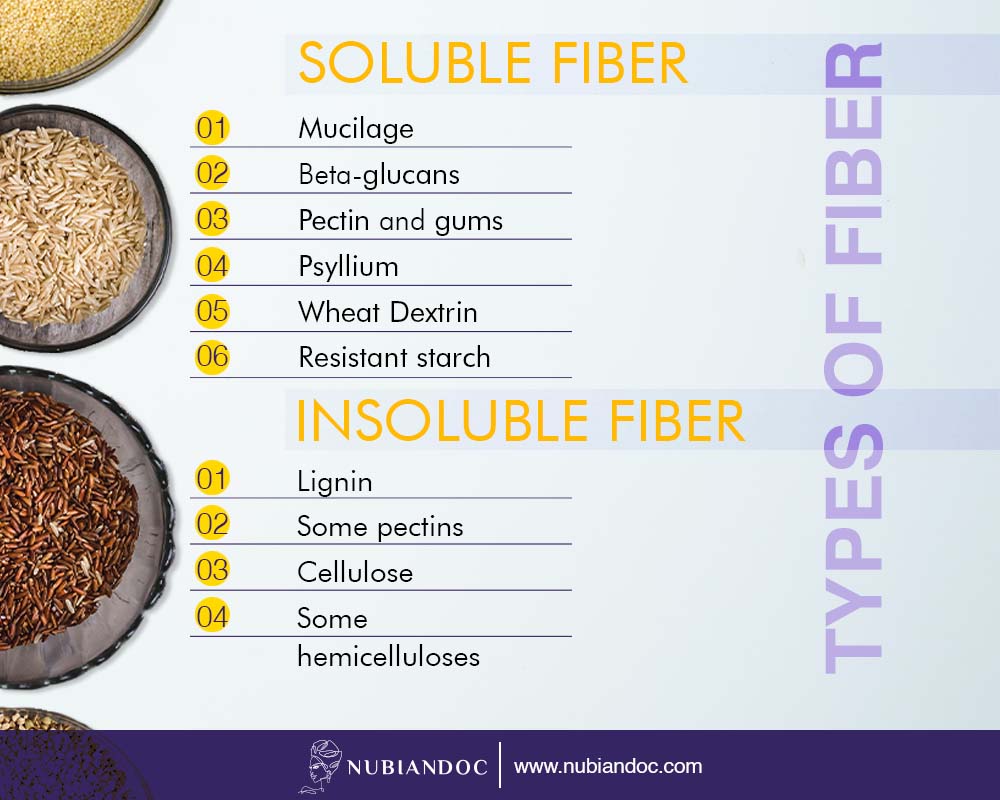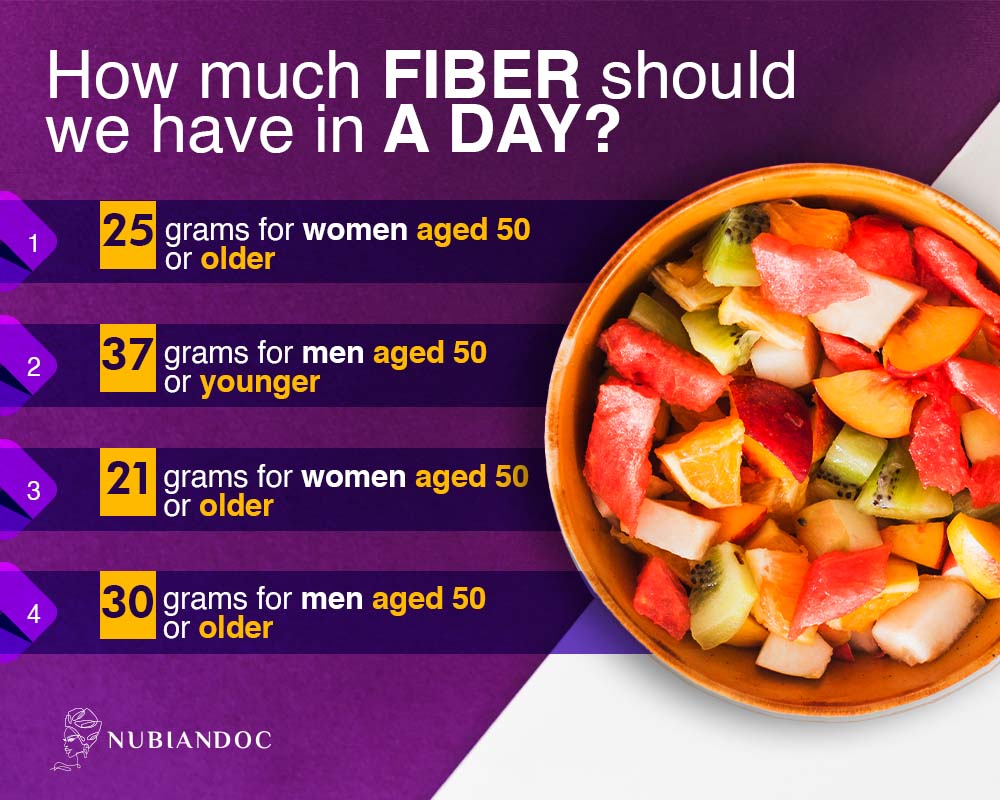Dietary Fiber Types | Sources | Health Benefits | Fiber & Diseases | Daily Fiber Intake | Ways to Increase | Bottom Line
Dietary fiber, also called roughage, is a carbohydrate that the human body cannot digest. Unlike most carbohydrates, fiber cannot be metabolized or broken down into simpler sugar molecules. Instead, it possesses the unique property of passing through the body undigested. Although fiber stays undigested for as long as it passes through the gut, its presence in the digestive tract plays an essential role in health. It is primarily found in legumes, fruits, vegetables, whole grains, etc. Fiber helps keep hunger and blood glucose level in check by regulating the body’s use of carbohydrates.
Wondering if there Are Any Types of Fiber? Here’s the Answer to Your Question!
If we dig deep, there is more than one type of fiber, and they all work in different ways to give health benefits. However, in a broader perspective, there are two major types of fiber:
These categories consist of several different nutrients that potentially affect our body positively.
Where Can We Get Dietary Fiber from?
Dietary fiber can naturally be sourced from a huge number of food items.

Summary: Dietary fiber is a carbohydrate that the human body cannot digest, but it plays a crucial role in various aspects of human health. Soluble fiber and insoluble fiber are two major types of dietary fiber.
Soluble Fiber
As the name indicates, soluble fiber gets dissolved in water, forming a mushy gel-like substance that when it interacts with other food particles in the gut mechanically slows down the process of digestion. This way, it takes longer for the human body to absorb glucose or sugar from the foods one eats. Therefore, it plays a vital role in the management of diabetes by helping prevent a quick increase in blood glucose levels. In addition, soluble fiber reduces bile acid absorption. These are molecules we release in order to absorb dietary cholesterol. Dietary cholesterol is found in varying degrees in all animal products we consume including dairy. By decreasing the amount of bile acids that are absorbed it also decreases your overall blood cholesterol levels. Sources of soluble fiber include nuts, beans, oatmeal, apples, lentils, etc.
Insoluble fiber
Insoluble fiber does not dissolve in water. Instead, it helps hydrate and move food through the digestive tract to prevent constipation and promote regularity. Insoluble fiber is mainly found in wheat, whole wheat bread, legumes, carrots, cucumbers, etc.
Under two major umbrellas, i.e., soluble and insoluble fiber, there are the following categories:

Summary: Soluble fiber is water soluble and helps decelerate the digestion process. As a result, it makes human body take longer to absorb glucose. Soluble fiber is found in nuts, beans, oatmeal, apples, lentils, and other foods. On the other hand, insoluble fiber does not dissolve in water. It promotes regular bowel movement through hydration. Wheat, beans, carrots, whole wheat bread, cucumbers, and other foods contain insoluble fiber.
Significance of Eating High Fiber Diet
The majority of the population in the United States does not get enough fiber from their daily diet. Research suggests that only 5% of the US population fulfills their requirements for adequate fiber intake. Dietary fiber makes an essential component of a healthy diet. It plays a vital role in keeping the digestive system healthy and may help reduce the risk of developing several chronic health conditions. There is ongoing scientific research that details the benefits and importance of adding fiber into your diet, ranging from keeping your gut healthy to helping reduce the risk of developing chronic conditions. Some of the benefits of dietary fiber are listed here:
Improved Gut Health
Fiber plays a vital role in keeping the digestive tract healthy. Adequate fiber intake can help alleviate the symptoms associated with constipation, and it allows food to move smoothly throughout the gut. In addition, it helps stimulate the growth of healthy gut microbiota as well.
Cereal fibers usually contain cell walls that hinder the process of digestion and work to retain water within their cellular structures. The fiber found in legumes and citrus fruits such as oranges stimulates the growth of intestinal flora, hence increasing fecal mass eventually. But it should be kept in view that a sudden increase in fiber consumption can cause abdominal bloating and flatulence; this can be modulated by beginning with small quantities and gradually increasing fiber intake. Since fiber absorbs water, fluid intake should also be increased as fiber consumption increases.
Effective Weight Management
For people who aim to manage their weight, a high-fiber diet can help them achieve their goals. Diets high in fiber help people feel fuller for a longer time and may help people adhere to their diet.
As mentioned earlier, soluble fibers with high viscosity thicken when dissolved in water, forming a gel-like compound in your gut. This gel-like substance helps slow down the stomach emptying and increases transit time by improving digestion and absorption. This results in significantly reduced appetite and feeling fuller for an extended time.
Helps Feed Good Bacteria
Your large intestine acts as a host for trillions of bacteria. Different species of bacteria in our gut work in different ways to play essential roles in various health aspects, including improving blood glucose regulation, sustainable weight management, and strengthened immune function. However, just like human organs, gut bacteria need to eat healthily to function properly. That’s when dietary fiber (primarily soluble fiber) comes into play.
As mentioned earlier, dietary fiber passes through your digestive tract undigested. However, upon reaching the large intestine, which is home to friendly gut bacteria, it gets digested by these gut bacteria and converted into a usable form of energy. This is how fermentable fiber (the fiber used by gut bacteria) helps feed healthy gut bacteria.
| Fiber Content in Different Foods | ||
| Fruits | 0.5 cup | 1.1 g |
| Meat | 1 oz | 0.1 g |
| Cooked legumes | 0.5 cup | 8 g |
| Whole grains | 1 oz | 2.4 g |
| Starchy vegetables | 0.5 cup | 1.7 g |
| Other vegetables | 0.5 cup | 1.1 g |
| Fruits | 0.5 cup | 1.1 g |
(Source: Wikipedia)
Helps Combat Chronic Inflammation
Ongoing scientific research suggests that consuming foods high in fiber may help lower chronic, low-grade inflammation. This can be associated with the fact that high fiber foods feed the healthy bacteria living in the gut, releasing substances that help lower the chronic inflammation throughout the body.
Moreover, some studies suggest that intake of a high fiber diet may lower C-reactive proteins (CRP) levels in the blood. C-reactive proteins act as a marker of inflammation, and their levels may go up in people with chronic inflammatory diseases. Therefore, a high fiber diet can be associated with reduced chronic, low-grade inflammation.
At NubianDoc, we are trying to disseminate information about healthy lifestyles and maintaining the quality of life through our informative articles; check out our blog.
Summary: Consumption of high fiber diet can help relieve symptoms of constipation by allowing food to pass through digestive tract easily. High fiber diet promotes satiety and help you feel fuller for prolonged time. It helps with effective weight management. Moreover, fiber feeds healthy gut bacteria that play an important role in lowering chronic inflammation.
How is Fiber Associated with Various Diseases? Keep Reading to Know the Answer
The fiber’s fatty acid-binding and inflammation-lowering properties may have been associated with effective management and reduced risk of developing various chronic diseases such as heart disease, type 2 diabetes, colon cancer, etc.
Here is a guide to the association of fiber intake with various diseases:
Fiber and Cardiovascular Diseases
According to several scientific investigations, high fiber intake may have been linked with a reduced risk of developing cardiovascular diseases and hypertension. This protective effect of dietary fiber can be because of its fatty acids binding properties, resulting in reduced levels of total cholesterol and low-density lipoproteins (LDL), also named Bad cholesterol, in the blood.
Fiber and Type 2 Diabetes
Foods with equal calories and carbohydrates can have drastically different glycemic effects. Generally, foods with high fiber content have a low glycemic index (Glycemic index is a figure assigned to food, representing the ability of carbohydrate-containing food to increase the blood glucose levels). Therefore, a low glycemic index diet or high fiber diet may benefit people with type 2 diabetes in regulating postprandial spikes in blood glucose levels. Thus, fiber intake, preferably through food, may help with the effective management of type 2 diabetes.
Fiber and Diverticulitis
Diverticulitis is a condition defined as the inflammation of the small pockets (diverticula) in the lining of intestine. Intake of a high fiber diet may help lower the risk of the development of diverticulitis. In addition, various observational studies suggest that high fiber (particularly insoluble fiber) intake may also reduce the recurrence of diverticular disease (development of diverticula in the lining of intestine).
Fiber and Constipation
A high fiber diet can help alleviate the symptoms associated with constipation, and it allows food to pass smoothly throughout the gut. Cereal fibers usually contain cell walls that obstruct the process of digestion and work to retain water within their cellular structures. High fiber foods help stimulate the growth of intestinal flora, therefore increasing fecal mass eventually. This and increased stool water content is how high fiber intake may alleviate the symptoms related to constipation.

Summary: High fiber intake may be linked with a reduced risk of developing cardiovascular diseases and hypertension due to its fatty acid-binding properties. A high fiber diet may benefit people with type 2 diabetes in terms of regulating postprandial spikes in blood glucose levels. Intake of a high fiber diet may help lower the risk of the development of diverticular disease. A high fiber diet can help alleviate the symptoms associated with constipation, and it allows food to pass smoothly throughout the gut.
How to Increase Your Dietary Fiber Intake
As discussed above, fiber has several health benefits. So, if you lack fiber in your daily diet, here are some suggestions that you can try to add more fiber:
Switch to Whole Grains
Add at least half of all grains from whole grains. Try to get your hands on products such as breads that list whole wheat, whole grain, or whole wheat flour on the label as their first ingredient, and it must also have added fiber. Do play with foods like brown rice, whole-wheat pasta, barley, and wild rice to make your diet high in fiber.
Eat Fruits and Vegetable-rich Diet
Fruits and vegetables make an excellent source of fiber, vitamins, and minerals. Try consuming at least 3 to 5 servings per day.
Make Your Snacks High in Fiber
A handful of nuts or dried fruits in your evening snack is an excellent source of fiber. Consume fresh fruits, raw vegetables, or whole grains in your snack time to increase fiber intake.
Count on Legumes
You can add beans, lentils, and peas to your diet to increase your fiber intake. For example, you can add beans to your green salad and your soups. These are some of the healthiest options to increase fiber in your diet.
Use Whole Grain Flour for Baking
For your baked goods, substitute whole-grain flour for half or (preferably) all of the white flour. Then, you can make oatmeal brownies and cookies while trying to sneak fiber into your diet.
Summary: To increase your daily fiber intake, you can switch to whole grains, consume more fruits and vegetables, consume high fiber snacks, and increase your intake of legumes.
Bottom Line
Although fiber stays undigested for as long as it passes through the gut, its presence in the digestive tract can play an essential role. It is mainly found in legumes, fruits, vegetables, whole grains, etc. Adequate fiber intake can help alleviate the symptoms associated with constipation, and it allows food to move smoothly throughout the digestive tract. A diet high in fiber helps people feel fuller for longer due to delayed stomach emptying and may help people with effective weight management. In addition, dietary fiber feeds healthy bacteria living in the gut, which eventually helps fight chronic inflammation. As a result, fiber may be associated with effective management and reduced risk of developing chronic diseases such as heart disease, type II diabetes, colon cancer, etc. To increase your daily fiber intake, you can switch to whole grains, consume more fruits and vegetables, consume high fiber snacks, and increase your intake of legumes.
If you cannot figure out how to attain a healthier lifestyle, NubianDoc is here to help you. With our customized 8-week health & wellness program, we can help you achieve your fitness and weight goals. Contact us now.
Also, check out our informative articles that aim to bring a healthier change in people.
[sc_fs_multi_faq headline-0=”h2″ question-0=”Does fiber have an association with colorectal cancer?” answer-0=”A high fiber diet has been linked with a reduced risk of colorectal cancer. In addition, various studies suggest that a diet high in grains and fiber content may help lower the risk of developing colorectal cancer.” image-0=”” headline-1=”h2″ question-1=”Does fiber intake help lower the risk of breast cancer?” answer-1=”High fiber intake in adolescence and early adulthood may help lower the risk of developing breast cancer in women. Studies suggest that women who consume high fiber foods such as fruits, vegetables, etc., in their young adulthood may have a lower risk of developing breast cancer.” image-1=”” headline-2=”h2″ question-2=”How much is the consumption of fiber considered too much?” answer-2=”Consuming more than 70 grams of dietary fiber per day is considered too much. In addition, it can cause unpleasant effects such as bloating, gas, and constipation.” image-2=”” headline-3=”h2″ question-3=”What is Functional fiber?” answer-3=”Functional fiber is a term used for fiber that is extracted from naturally available sources and, in order to increase fiber content, it is then added to dietary supplements and fortified foods and drinks.” image-3=”” count=”4″ html=”true” css_class=””]


